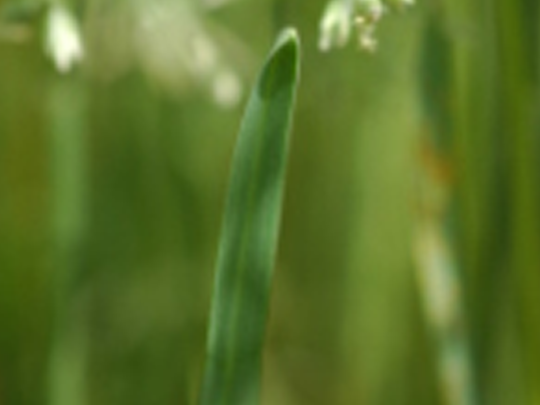Perennial grass with long, strong rhizomes. New tillers continuously arise from these underground runners to produce a dense sward. Flowering period May/June. Widely distributed on grassland and other green areas. Drought-tolerant, winter-hardy even during prolonged snow covering and so commonly found in mountainous regions. Prefers light mineral soils and peaty soils. Well-aerated loamy soils are also suitable, provided that they don't inhibit rhizome growth. The broad-leafed smooth stalked meadow grass is a valuable and productive pasture grass with a feed value of 8. Due to slow germination, smooth stalked meadow grass is late to emerge. It is often used for turfed areas that are subject to heavy wear, such as playgrounds and sports pitches. Slender-leafed cultivars that produce a particularly hard-wearing and dense sward are available.
| Leaf | Leaf folded in the bud, leaf sheath closed and flattened at the base. Leaf blade 3–6 mm wide, linear with boat-shaped tip which splits open when flattened. Dark green, and slightly shiny on the underside. The blade has no ribs but when held up to the light, two transparent tram lines are visible on each side of the midrib on the upper surface. Leaf blades vary in length; the basal leaves are long and the stem leaves relatively short. Short, straight ligule. Auricles absent. |
| Culm | Mostly erect, between 30–90 cm tall. Culm stem round and unbranched. |
| Inflorescence | Pyramid-shaped panicle up to approx. 15 cm long. 3–5 side branches at the lower nodes of the main axis. The inflorescence is spread during flowering and subsequently closed. 3–5 florets per spikelet. Glumes sharply pointed, awnless but with long hairs at the base (“panicle wool”). |
| Fruit | Grain triangular in cross-section. Rough yellowish-brown lemma with shaggy hairs at the base. Palea keel with long teeth, pedicel short and stubby. Caryopsis pointed at the top and bottom, triangular and yellowish-brown. TSW 0.2–0.4 g. |

